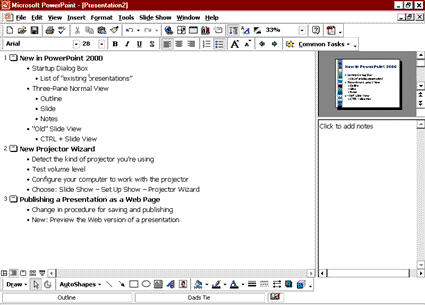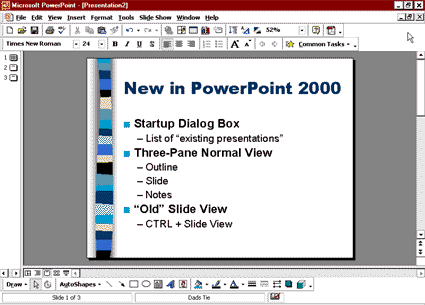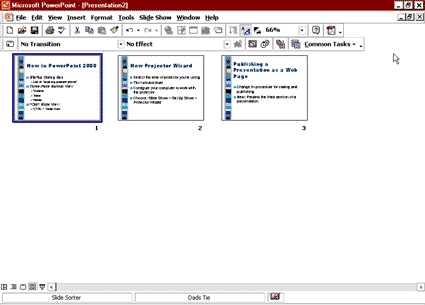|
|
|
The Many Views of Your
PowerPoint Presentation
|
|
|
There are five different ways you can view your PowerPoint document.
To get to each different view you can use the View buttons located at the
lower left of the PowerPoint application screen next to the horizontal
scroll bar (see Figure 1, below). From left to right these are Normal View,
Outline View, Slide View, Sorter View, and Slide Show View. All of these
view types can also be found under the View menu at the top of the screen.
FIGURE 1. View Buttons
Left to right: Normal, Outline,
Slide, Sorter, and Slide Show |
|
Normal
View
The Normal View is the default consisting of three panes (see Figure 2,
below). The left pane displays a slide show outline (containing the same
information as the Outline View); the upper right
pane displays the slide itself (equivalent to the Slide
View); and the bottom right pane provides a place for you to include
notes about the slide.
| A note about notes: Including notes for each slide can come
in handy if you give the same presentation, say, about every month or so,
and you don't have time to review your notes but you want to remember to
say the same things each time. You can create your own printed guide for
your presentation — including the details that your individual slides don't
show, as well as give yourself reminders of supporting research, credit/attributions
for graphs, photos or content, and even jokes! It is also handy for when
you must let someone else give your presentation for you because all the
supporting notes and information can be included for each slide. |
FIGURE 2. Normal View |
Outline View
Outline View changes the hierarchy of the three panes so that the largest
pane contains the outline (text) version of your slides (see Figure 3,
below).
| Note: You can display the outline only (without the other two
panes) by holding down the CTRL
key and clicking the Outline View button. |
FIGURE 3. Outline View |
| |
| Hints: (1) To select an entire slide, move the cursor over to
the little icon on the left of the slide until the cursor changes into
a cross-hair and then click on it. (2) To indent/unindent, use the green
arrow buttons Double-click on a word to highlight it. |
Slide View
Slide View shows you each individual slide, one at a time (see Figure 4,
below) with outline icons also visible in a narrow pane at the left of
the window.
| Note: You can display the slide only (without the outline icons)
by holding down the CTRL
key and clicking the Slide View button. |
FIGURE 4. Slide View |
| |
You can view another slide in one of the following ways.
-
Move through the slides by clicking the up (reverse) and down (advance)
buttons on the lower right corner of your screen.
-
Use the scroll bar to quickly go to a slide (notice how it tells you numbers
of the slides as you scroll).
-
Click on the outline icon of the slide you want to view.
Sorter View
Slide sorter view displays all of your slides as thumbnails (see Figure
5, below). From this view you can see if things line up between the slides
the way you want them. You can also select a slide and drag it to a new
location, or cut a slide and paste it to a new location. Transitions and
effects are created from this view as well (see Part 6, "Building
Transitions and Effects on Your Slides").
FIGURE 5. Sorter View |
| |
Notes:
-
You can select more than one slide by holding down the SHIFT
key and clicking on each of the slides you want.
-
By changing (i.e., increasing) the zoom setting in slide view you can better
read the content on the thumbnails.
|
Slide Show View
Slide Show View shows you how your presentation (or transparency slides)
will look when you project it on a screen (see Figure 6, below). Use your
SPACEBAR
or mouse-click to advance to the next slide — or use the up/down arrows
to advance and go back. Tap the ESC
key to exit this view.
FIGURE 6. Slide Show View |
| |
|




